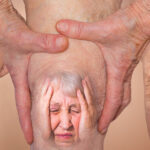Intra-articular corticosteroid + lidocaine added to best current treatment reduced pain and improved function in hip OA patients, according to a large UK study.
A UK study has found that adding a single ultrasound-guided corticosteroid and lidocaine injection to advice and education led to greater pain reduction and improvement in function in hip OA patients than advice and education alone.
“These findings provide evidence to inform international guidelines and offer important choice to patients, who often believe their treatment options are limited,” wrote the study authors.
The study, published in the British Medical Journal, included 199 hip OA patients with at least moderate pain. They were randomised to one of three groups: a control group, which received advice and education (best current treatment, BCT); a group that received BCT plus an ultrasound guided intra-articular hip injection of 40 mg triamcinolone acetonide and 4 mL 1% lidocaine hydrochloride; and a group that received BCT plus 5mL 1% lidocaine.
The primary outcome was patient-reported hip pain intensity on a 1-10 numerical rating scale at two weeks, two months, four months and six months. Secondary outcomes included pain self-efficacy, physical function and sleep.
Over the six-month trial, participants in the BCT plus triamcinolone-lidocaine group reported a greater reduction in pain intensity compared to those receiving BCT alone (-1.43 overall, p<0.001) and BCT plus lidocaine (-0.52 overall, non-significant).
Generally, greater differences were seen at earlier time points (two weeks and two months) than at later time points (four and six months), and no significant differences in pain or function were reported at the six-month time point.
Seven serious adverse events were recorded, of which one – a death from subacute bacterial endocarditis – was possibly related to trial treatment. The authors noted that “clinicians should specifically exert caution and carefully counsel patients with risk factors for endocarditis, such as those with a prosthetic heart valve.”
The study is the largest randomised controlled trial of intra-articular corticosteroid injection in hip OA, with other strengths being the inclusion of two comparison arms, the length of follow up and the high response rates.
The Australian guidelines for management of knee and hip OA conditionally recommend corticosteroid injections for people with moderate to severe pain, with the caveat that the studies upon which the recommendation was based were small and at risk of bias, and that there was a lack of long-term data.
“It’s always encouraging to see benefit from things we can affordably do now,” said Dr David Liew, rheumatologist and deputy editor of Rheumatology Republic. “We certainly aren’t overwhelmed with choice when it comes to non-invasive options for hip osteoarthritis.”
The self-reported outcomes may have been a study limitation, because the comparisons between BCT vs BCT plus intra-articular injections were unblinded (and placebo saline injections were considered not ethically appropriate). Other limitations included a lack of radiographical outcomes and mostly white ethnicity.
Rheumatology Professor Anita Wluka of Monash University’s Department of Epidemiology and Preventive Medicine pointed to the placebo effect of the injection as a shortcoming of the study.
“The placebo effect of having an injection into the hip may have been responsible for much of the improvement,” she said.
“This is supported by the significantly reduced difference between outcomes for the two injection groups. The difference in pain reduction was significantly less and is unlikely to have been clinically important. The addition of corticosteroid appeared to provide only a small incremental benefit, of unlikely clinical importance,” said Professor Wluka.
Professor David Hunter of Sydney University and Royal North Shore Hospital agreed, saying “There is no clinically important difference in pain for the different injection types. I’m not suggesting it is all placebo but that is an important component of the result.
“Should it change practice? Probably not,” he added.
Sydney rheumatologist Dr Shirley Yu said, “I don’t think the study is enough to address the concerns noted in the 2018 Australian guidelines, and ongoing larger studies are required. Steroid injection for hip OA should still be conditional and we need to consider our target population appropriately.”
The authors cautioned that further studies are needed to investigate the safety, effectiveness, and optimal timing of repeated corticosteroid injections, with other studies linking a loss of cartilage volume or radiographical evidence of worsening of osteoarthritis with multiple corticosteroid injections.
This article was updated 8 April 2022 to include additional comment.





